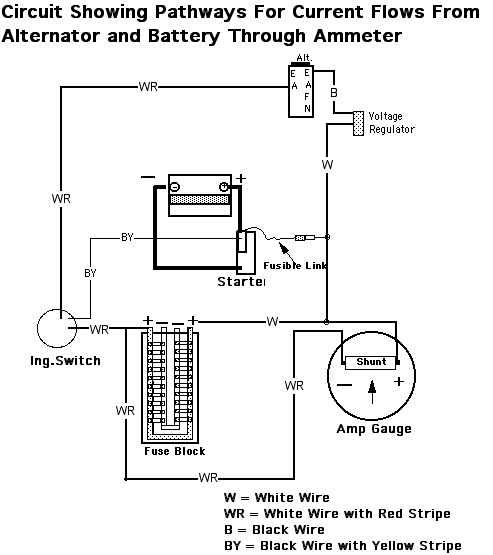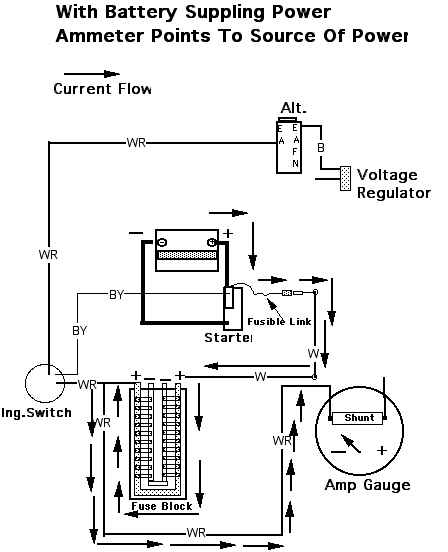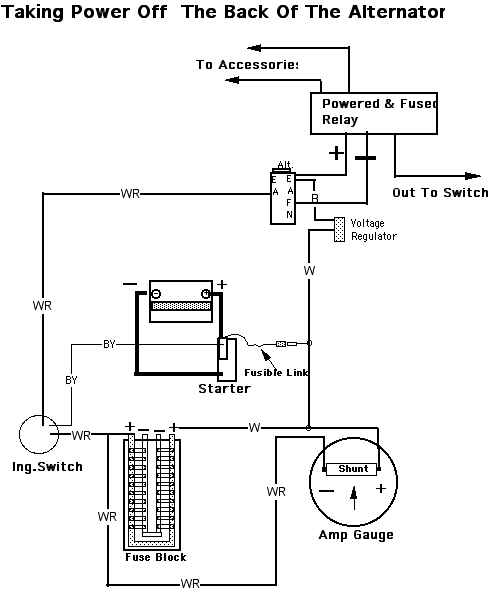Understanding The Ammeter Setup In Your 240-Z

Understanding The Ammeter Setup In Your 240-Z

The Purpose of this page is to give the reader a very basic understanding of how the Ammeter in the 240-Z is wired, how it works, what it tells you; and if you are thinking of adding higher capacity alternators or batteries what the possible effect could be.
That main power source can come from two directions into the ammeter; either from your Battery (indicated by a -minus reading on the ammeter) or from your alternator (indicated by a +plus reading on the ammeter). The ammeter also tells you how large that current flow is.
Take a look at the first diagram below: This shows the main pathways, through the wiring involved, to the ammeter. These are complete circuits - and thus form a couple of different loops through which current "can" flow. To better understand how it "does" flow under different conditions see the second and third diagrams that follow. Note: the diagrams are all greatly simplified compared to the actual schematics! None-the-less, here we are only looking for basic understanding.




Question: If I install a power hungry stereo amp., high wattage lights, a high amperage cooling fan etc. etc.. Then install a higher amperage alternator to supply the additional current needed. Do I have to change or remove the ammeter? I don't want to burn it out!
Answer: Your Z's original wiring was only designed/intended to handle a certain amount of current. By-passing the ammeter, only risks damage to your fuse block or other wiring in the system. Additions to the car that require additional current - should be made entirely outside the original wiring and they should be feed current directly from the back of the higher amperage alternator, rather than from the Positive Terminal of the battery. (fuse protected of course).
As the battery is actually recharged through the feed coming from the alternator and going into the ammeter, placing additional loads on the battery terminal will result in greater current running through the voltage regulator and on through that line to the ammeter. (see figure 3)
If you add circuits outside the original wiring harness it would not be a bad idea to add a Voltmeter. This would provide you with needed information to assure that the battery is being recharged when additional demand is put on the alternator.
Question: What's the "Shunt" in the ammeter do?
Answer: The shunt is a very low resistance bridge across which the full line current passes. The ammeter actually uses very little current to operate the indicator needle on the front of the gauge. If you wanted to double the current carrying capacity of the ammeter, you could install a second shunt in parallel with the first - thus splitting the load between the two. This would protect the ammeter, but it could also allow you to pass too great a current load to the rest of the wiring. (not recommended).
Question: When I start my Z, the needle on the ammeter will swing toward the - (minus) sign, then as the engine runs the needle will swing to the +(plus) position. Doesn't that mean that my battery is being recharged?
Answer: NO - it simply means that the current flow is coming from the alternator and it gives you an indication of how large that current flow is. Only if everything else in the charging system is as it should be, will the battery actually be recharged. You could for example have a lose battery terminal, and even though power is being sent to the battery, it still isn't being recharged. To monitor the state of charge of the battery you need to install a Voltmeter.
Question: What is the output capacity of my original alternator and how much more capacity could I safely add.
Answer: For the 70/71 model years the 240-Z was equipped with a 45 Amp. rated alternator. It would put out about 37.5 Amps. at 2,500 RPM or 45 Amps at 5000 RPM. For the 72/73 model years the alternator was rated as a 50 Amp. Also for 1973 the ammeter was rated at 60 Amps, rather than the 45 Amp rating of the 70-72 model years.
Question: I see a "fusible link" shown in the diagrams - what is that?
Answer: A fusible link is simply a section of wire that will melt when overloaded, performing the same function as an in-line fuse. Pre-made fusible link wire setup's with built in eyelet terminal are available in the "HELP" section of most automotive supply stores.
Question: I installed a powerful stereo amplifier, ran power from the Positive terminal on the battery to a relay. Now whenever I have the stereo turn on, the ammeter shows a constant +Plus reading. It never seems to recharge the battery and return to the center of the gauge. Whats up with that?
Answer: Remember, your ammeter does not show the state of charge for your battery, it simply shows current flow from the alternator feeding a load somewhere. As long as you have your amplifier drawing power - the ammeter will show the flow. If you amplifier is drawing more additional current than your alternator can provide you battery will supply the additional current needed. In which case you could be discharging your battery in spite of the "+" reading show on the ammeter.
If you feed a relay directly off the back of the alternator, to power the amplifier, you would not see the current flow to the relay, on the ammeter. You would also see a "-"minus indication on the ammeter if the alternator was not putting enough current out to recharge the battery.